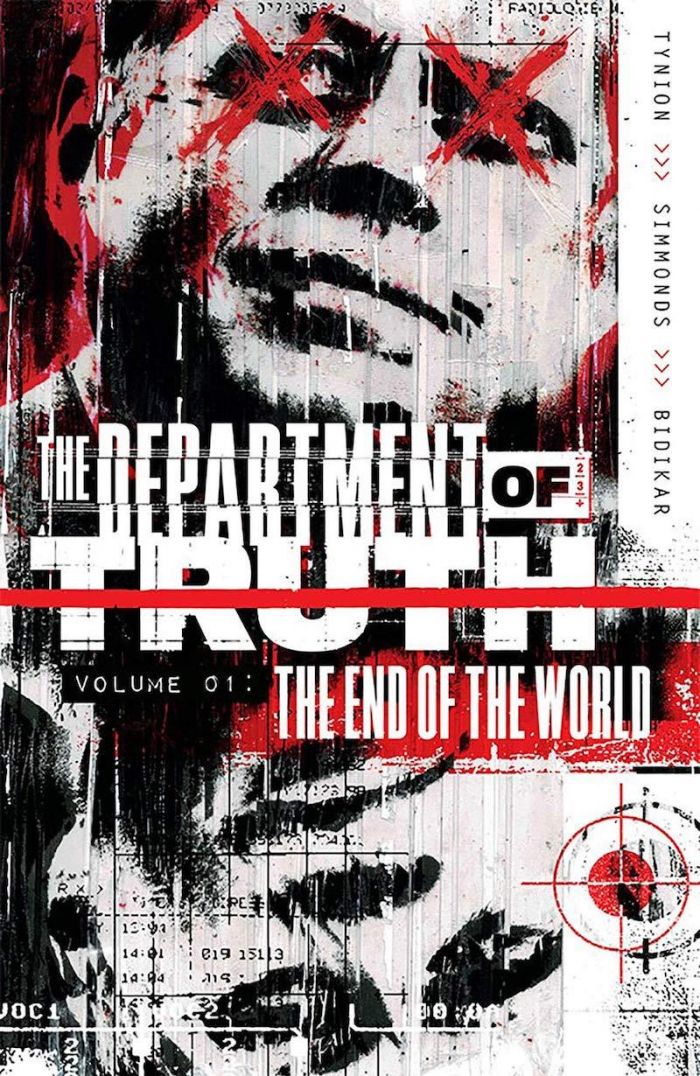The Department of Truth, Volume 1 by James Tynion IV, Martin Simmonds (Review)

We live in a day where conspiracy theories are no longer the purview of obscure internet forums, kooky uncles, and people who’ve taken one too many bong rips. In the last few years, they’ve come to dominate and undermine our social, political, and cultural discourse to an increasingly disturbing extent.
School shootings are no longer national tragedies; they’re actually false flag operations intended to bring about stricter gun laws. Vaccines are no longer scientific wonders that alleviate human suffering; they’re actually harmful tools of control. Donald Trump didn’t lose the 2020 election; the election was actually stolen from him. QAnon isn’t absolute nonsense; there actually is a cabal of Satanic cannibal pedophiles who control Washington and Hollywood and run a global sex-trafficking ring — and Donald Trump is the only person who can stop them.
As an FBI agent, Cole Turner studies conspiracy theories and online extremism for a living. His research leads him to a Flat Earth conference, where the conference’s shady organizers give him shocking proof that the Earth, as it turns out, is actually flat. Or is it?
Before Turner can make sense of anything he’s seen, he’s rescued and subsequently recruited by operatives from The Department of Truth, an ultra-covert organization led by Lee Harvey Oswald — yes, that Lee Harvey Oswald — whose mission is to prevent conspiracy theories from gaining traction in the zeitgeist and reshaping reality.
Note: The following contains potential spoilers for The Department of Truth, Volume 1.
Cole’s new mission is easier said than done, however, and fraught with moral quandaries and gray areas. The Department is up against some truly insidious and devilish forces, namely the Black Hat organization, but combatting them sometimes requires doing terrible things of their own.
In the first volume’s most heart-wrenching issue, Turner and another agent visit a woman targeted for abuse by conspiracy theorists (including a certain Alex Jones-like figure) after her son was killed in a school shooting. Overwhelmed by grief, she slowly begins to buy into the conspiracy that the shooting was faked, if only because doing so gives her a slim hope that her son is still alive somewhere. Allowing this idea to spread is dangerous, though, so Turner must steal all of the woman’s research, thus dooming her again to the truth: that her son really is dead.
What follows is a fascinating discussion between Turner and his comrade concerning the morality of their assignment. But as his fellow agent reminds him, “This isn’t a clean job, Cole. It’s ugly because people are ugly, and they can believe terrible, ugly things.”
In subsequent issues, the existence of the Department itself becomes increasingly murky and unclear. Is the Department of Truth a force for good, or are they more intent on their own agenda and survival? And to what extent are the two one in the same? When outsiders come too close to exposing the Department’s existence, is it better to dismiss them and hope the story goes away? Or do they need to be eliminated lest their revelations create a new conspiracy theory that could undermine the Department’s activities?
As if this weren’t enough, Turner has his own agenda for joining the Department: he wants the truth behind his childhood involvement in the so-called Satanic Panic that swept through America during the ’80s. On a personal note, this really brought The Department of Truth home for me, as I was a church kid who grew up during the Panic. I read about the warning signs of cult activity, watched videos in youth group that revealed the Satanic influences in rock n’ roll, and whispered hushed rumors about where Satanists might be committing their nefarious activities.
The Department of Truth’s first volume is excellent. James Tynion IV’s (Batman, Something Is Killing the Children) story is certainly ambitious, weaving together all manner of conspiracies with online outrage culture, American history, and the Buddhist concept of tulpas (i.e., thoughts that manifest themselves in physical reality). More importantly, it feels scarily relevant in light of the January 6 insurrection and the fact that we have elected officials who actually buy into QAnon’s inanities.
Meanwhile, Martin Simmonds’ (Dying is Easy, The Immortal Hulk) painterly art, Aditya Bidikar’s (Batman Black & White, John Constantine: Hellblazer) lettering, and Dylan Todd’s (Mech Cadet Yu, Mighty Morphin Power Rangers) graphic design all combine to create an abstract, nightmarish visual experience that’s perfectly suited for a series about a troubled man confronting the truth behind some of the world’s darkest, strangest stories.
Given how convoluted things could become with the Department’s cases and history, their struggle against Black Hat, and Turner’s own personal history — sidenote: I wonder what gay agenda-related conspiracy theories The Department of Truth will explore given Turner’s homosexuality (gay frogs, perhaps?) — there’s a sense that the series could fly off the rails at any moment. In its timely exploration of conspiracy theories, The Department of Truth might go too far down the rabbit hole. But with this first volume, anyway, it’s off to a solid start and packs a definite sense of energy and enigma, and I eagerly await future volumes.
Click here to read the first issue of The Department of Truth.